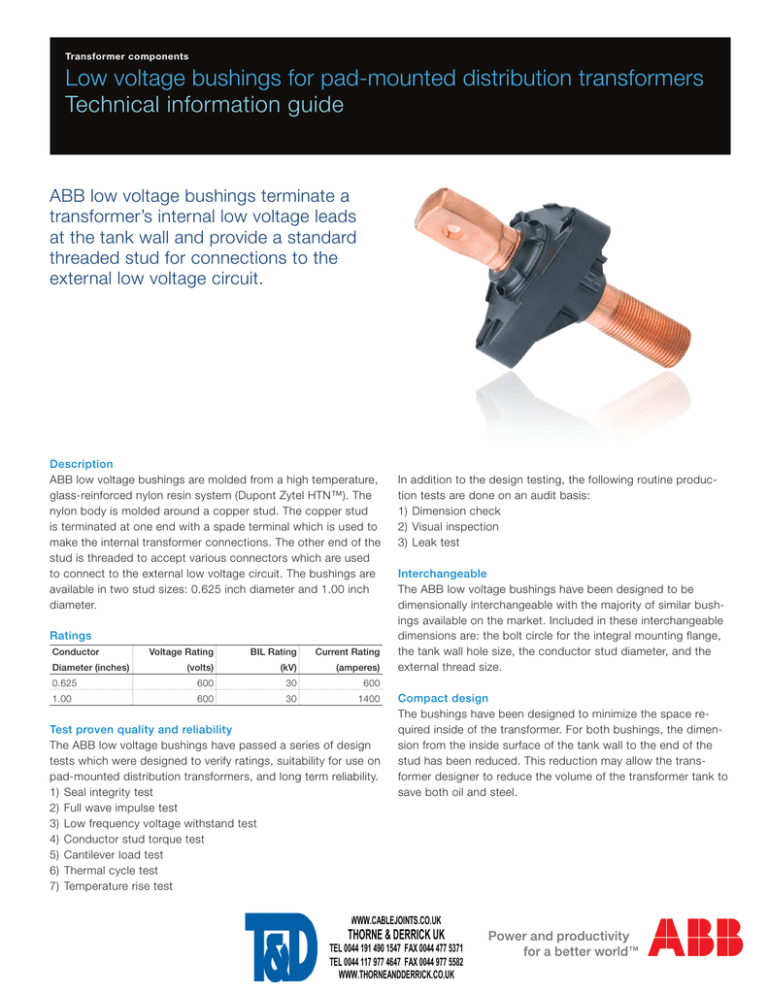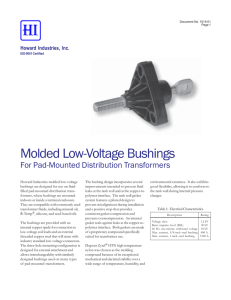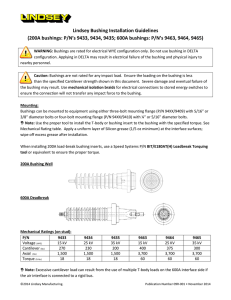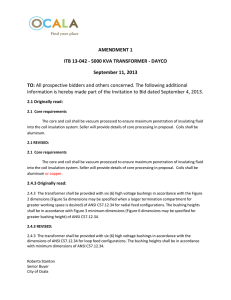
Transformer components
Low voltage bushings for pad-mounted distribution transformers
Technical information guide
ABB low voltage bushings terminate a
transformer’s internal low voltage leads
at the tank wall and provide a standard
threaded stud for connections to the
external low voltage circuit.
Description
ABB low voltage bushings are molded from a high temperature,
glass-reinforced nylon resin system (Dupont Zytel HTN™). The
nylon body is molded around a copper stud. The copper stud
is terminated at one end with a spade terminal which is used to
make the internal transformer connections. The other end of the
stud is threaded to accept various connectors which are used
to connect to the external low voltage circuit. The bushings are
available in two stud sizes: 0.625 inch diameter and 1.00 inch
diameter.
Ratings
Conductor
Voltage Rating
BIL Rating
Current Rating
(volts)
(kV)
(amperes)
0.625
600
30
600
1.00
600
30
1400
Diameter (inches)
Test proven quality and reliability
The ABB low voltage bushings have passed a series of design
tests which were designed to verify ratings, suitability for use on
pad-mounted distribution transformers, and long term reliability.
1) Seal integrity test
2) Full wave impulse test
3) Low frequency voltage withstand test
4) Conductor stud torque test
5) Cantilever load test
6) Thermal cycle test
7) Temperature rise test
In addition to the design testing, the following routine production tests are done on an audit basis:
1) Dimension check
2) Visual inspection
3) Leak test
Interchangeable
The ABB low voltage bushings have been designed to be
dimensionally interchangeable with the majority of similar bushings available on the market. Included in these interchangeable
dimensions are: the bolt circle for the integral mounting flange,
the tank wall hole size, the conductor stud diameter, and the
external thread size.
Compact design
The bushings have been designed to minimize the space required inside of the transformer. For both bushings, the dimension from the inside surface of the tank wall to the end of the
stud has been reduced. This reduction may allow the transformer designer to reduce the volume of the transformer tank to
save both oil and steel.
WWW.CABLEJOINTS.CO.UK
THORNE & DERRICK UK
TEL 0044 191 490 1547 FAX 0044 477 5371
TEL 0044 117 977 4647 FAX 0044 977 5582
WWW.THORNEANDDERRICK.CO.UK
Technical information
Integral flange
The mounting flange on the bushings is molded as an integral
part of the bushing. This eliminates the need for a separate
mounting flange and, in the case of a metal mounting flange,
the associated electrical losses created by the induced current
in the flange.
Low frequency / 60 Hz withstand test
The purpose of the low frequency withstand test is to verify the
integrity of the insulation structure of the bushing at operating frequency. Bushing samples were tested at 12 kV for one
minute and then allowed to rest for one minute. They were then
retested for another minute. All samples passed this test.
Compression limited gasket designs
The integral flange of the bushing has a molded-in gasket
seat to ensure proper gasket location and compression during
mounting. The gasket surfaces provide controlled compression
and containment of the highly resilient Buna-N gasket.
Mechanical strength tests
Leak tests
The purpose of the leak test is to ensure that, over the life of the
bushing, no leak will develop between the copper stud and the
nylon resin body. The bushings were tested using a helium leak
detector. The sensitivity of the helium leak detector is 1 x 10-5
atm cc/sec. The bushings were attached to a leak test fixture
which mates the bushing such that any leak will be detected if
helium passes into the detector through the bushing. All bushings passed with no indication of leaks.
Conductor length
Bushings are available with a standard or extended length
thread design.
Proven nylon body
These ABB bushings are molded from a glass-reinforced, high
temperature nylon resin (Dupont Zytel HTN). The Zytel HTN resin
is a highly reliable thermoplastic that fulfills the required application needs for strength, temperature stability and low moisture
absorption. The resin system retains its mechanical and electrical
properties in the high temperature environment associated with
pad-mounted distribution transformer applications.
Certification
To certify the product ratings, production samples of the bushings were tested. The tests were conducted in accordance with
ANSI/IEEE standards where applicable.
Design tests
The design tests were divided into (3) three categories:
1) Dielectric tests (impulse test and 60 Hz withstand test)
2) Mechanical strength tests (leak test, stud interface strength
test and cantilever test)
3) Environmental tests (thermal cycle test, oil compatibility test)
Dielectric tests
Impulse test
The purpose of this test is to verify the impulse withstand of the
bushing. Sample bushings were subjected to three positive and
three negative full wave impulses. The voltage impulse used
was the standard 1.2 x 50 µs wave having the crest value of the
specified voltage. The withstand voltage level of the bushings
are well above the BIL rating of 30 kV. Samples successfully
passed 36 kV test levels. Samples also successfully passed
chopped wave tests well above the rating of 36kV.
Stud interface strength test
The purpose of this test is to verify that no damage will result
when terminals are connected or removed from the bushings.
The bushings were mounted in a manner simulating a typical transformer installation, then a nut was threaded onto the
copper stud and 50 foot-pounds of torque was applied. For
the 0.625 inch diameter copper stud bushing, the stud will fail
before the 50 foot-pound level is reached. For the 1.00 inch
diameter copper stud bushing, the 50 foot-pound torque test
was repeated 20 times.
Finally, the bushings were leak tested to verify that the seal
between the copper stud and the nylon resin body was not
damaged. Both the 0.625 and 1.00 inch low voltage bushings
successfully passed this test.
Cantilever test
This test demonstrates the ability of the bushing to withstand
the stresses generated when attaching a lead to the conductor.
With the bushings mounted in a manner to simulate its application on a transformer, an extension was threaded onto the
bushing stud and a load applied until failure.
The 0.625 inch bushing was mounted so that one of the mounting
holes is at the 6 o’clock position. Then a cantilever load was applied, resulting in the stud yielding before the bushing body failed.
The 1.00 inch bushing withstood 280 foot-pounds when
mounted with one of mounting holes in the 12 o’clock position
and withstood 375 foot-pounds when mounted with one of the
mounting holes in the 6 o’clock position.
2 Low voltage bushings for pad-mounted distribution transformers | Technical information
Technical information
Environmental test
Thermal cycle test
The purpose of the thermal cycle test is to verify the integrity of
materials used in the bushing over the expected service life of
the bushing. The previously leak tested bushings were subjected to 20 thermal cycles in air. Each thermal cycle consists of
the following:
1) 1-hour transition to 140 °C
2) 2-hour hold at 140 °C
3) 1-hour transition to -40 °C
4) 1-hour hold at -40 °C
Oil compatibility test
The purpose of this test is to verify that the bushing does not
have any damaging effects on the properties of the oil when
the bushing is submerged in the transformer oil. The bushing
passes the standard oil compatibility test.
Technical information | Low voltage bushings for pad-mounted distribution transformers 3
ABB Inc.
1128 South Cavalier Drive
Alamo, Tennessee 38001, USA
Phone: +1 731 696 5561
Main: +1 800 955 8399
Fax: +1 731 696 5377
Email: alamo.customer_service@us.abb.com
www.abb.com/electricalcomponents
Note:
We reserve the right to make technical changes or modify the contents of this
document without prior notice. The information, recommendations, description
and safety notations in this document are based on our experience and judgment.
This information should not be considered all inclusive or covering all contingencies. ABB does not accept any responsibility whatsoever for potential errors or
possible lack of information in this document. If further information is required,
ABB Inc. should be consulted.
We reserve all rights in this document and in the subject matter and illustrations
contained therein. Any reproduction in whole or in parts is forbidden without prior
written consent from ABB Inc.
With regard to purchase orders, the agreed particulars shall prevail. In no event
will ABB Inc. be responsible to the user in contract, in tort (including negligence),
strict liability or otherwise for any special, indirect, incidental, or consequential
damage or loss whatsoever including but not limited to use of equipment, plant
or power system, cost of capital, profits or revenues, cost of replacement power,
additional expenses in the use of existing power facilities, or claims against the
user by its customers resulting from the use of the information, recommendations,
description and safety notations contained herein.
Copyright 2011 ABB.
All rights reserved.
1ZUA2761-600 – rev. 4
For more information please contact:
1ZUA2761-600 – rev. 2, 13 September 2007
7 / 10
1ZUA2761-600 – rev. 2, 13 September 2007
8 / 10
1ZUA2761-600 – rev. 2, 13 September 2007
WWW.CABLEJOINTS.CO.UK
TEL 0044 191 490 1547 FAX 0044 477 5371
TEL 0044 117 977 4647 FAX 0044 977 5582
WWW.THORNEANDDERRICK.CO.UK
9 / 10
THORNE & DERRICK UK




